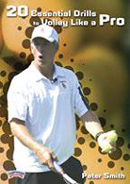Pete Sampras and the
Two-Step Volley
Peter Smith
When we talk about the development of Pete Sampras, it is well known that Robert Lansdorp and Pete Fischer were critical in helping Sampras develop his groundstrokes and his serve. Another great Southern California coach, Larry Easley, also deserves acknowledgement in the development of Pete's volleys and attacking-style movement.
I know the role Larry played because I witnessed it first hand. In college I had the pleasure of playing for Larry at Long Beach State in the 1980s. Larry had been the head pro at the Jack Kramer club before he was at Long Beach State, where Sampras and also Pete Fischer were members. Fischer would take Sampras to 4 different coaches every week for different parts of his game and Larry was his volley coach.
Sampras would be at our team practices on Friday doing drills with the team and staying after to work on his volley. We could all see the talent in Pete and it certainly was not a surprise to me what he did in tennis. You could see it on the court even at that age. I used to introduce him to people around campus saying this is Pete Sampras, he'll win the US Open one day. When he won the Open for the first time, our basketball coach called me saying "That was the kid, wasn't it?"
The Two Step Volley
Larry had a very simple concept that he called the Two Step Volley. He was the first and one of the very few people I have heard ever teach this concept. Pete mastered it in about two seconds, and I am still using it and teaching it to my own players. Pete may be retired, but we can still learn the fundamentals of the volley by studying the impeccable technique he developed working with Larry. I want to note that this article is dedicated to Coach Easley, who recently passed away after a battle with ALS, or Lou Gerhig's Disease. He helped me immensely and his influence will always be a part of the way I coach.
Pete was such a great athlete even at age 12 that he never looked like he was trying in practice--and sometimes he wasn't. But he had an extra gear that I have not seen in tennis, similar to the way Michael Jordan played basketball. He would cruise along and then explode when he needed to. He was one of the first great athletes in tennis who also had great technique.
When we compare video of Pete to some of the other top volleyers, his simplicity and efficiency stand out. If you watch Pete volley the one thing you will notice is how balanced he is. The reason he is so balanced is because his movement is pure and there is nothing extra or wasted. This is one of the most important things with the volley because when you are at the net the play is now twice as quick as a groundstroke and a volley is usually a finishing shot. Therefore the pressure is always there to make it happen. This pressure will cause your flaws to be exposed and magnified.
In my opinion, what made Pete so great at the net is what Larry taught him. He was taught at a very young age how to move correctly at the net. Be efficient with your feet. Be simple with your stroke. Go to the ball with your feet. This simplicity, along with Pete's athleticism, distinguishes him as the greatest volleyer of his generation, and one of the greatest of all time. This movement helped him in so many areas not just on the volley but on the return and all attacking shots.
Two Step Sequence
The volley starts with the split step, although Pete morphed this later into a more advanced move described below. But what is not understood is exactly what happens next. From the spilt step you need to do two things. First, pivot or step toward where the ball is going to be with the foot closest to the ball (the outside foot). The goal is to align the back foot with the contact point. The key is getting a big push in this first move is pushing hard with the other foot. This is especially important when you are moving further to reach the ball, either moving forward or to the side.
You can see this in the video as Pete moves to a backhand volley. He is not only stepping with his left foot, he is also getting a big push from right foot. Notice that as Pete is taking this step he also pivoting. The pivot is a big key because it is responsible for starting the body turn. John Yandell calls this the unit turn but I have always called it pivoting. It's the same thing. The pivot in conjunction with the shoulder turn takes the racquet back automatically. The racket and the arms don't move independently. They are along for the ride. As I grew up in tennis, I was around some great coaches, but no one ever talked about the outside foot or the pivot, until I played for Larry.
The purpose of the step is to position the player behind the oncoming ball and on balance. From this position the second step in the two step volley should be in the direction you are hitting the ball. Although the foot is often still in the air, this step is initiated before contact with the ball. From there you only need to finish the volley, which is now the easy part.
Even at high levels, you always have time for this pivot and step. One of the hardest concepts to grasp is how big, or small that outside step should be. If the ball is basically right at the player's forehand volley, the sequence would be: pivot right foot, step forward with the left foot, volley, split step.
But the size of the first step will adjust depending on the exact direction you are moving and how far you are from the ball. If the ball is further away, the player takes a bigger first step but maintains balance. The second step will usually be larger as well. It is important to understand that this pivot step can be to the side, diagonal or a step forward. My good friend David Roditi teaches this as "1-2-3." 1-for the pivot/step and shoulder turn, 2-for the volley and step forward and 3-for getting balanced again in your split step.
On the groundstrokes you can not lunge to the ball and still get power. The same is true with the volley. You need to get your outside foot behind the volley before you step forward (not directly across) and hit the ball. For most volleys you do not need (or have time for) more than two steps. In fact if you move correctly, you then can easily touch either side line with two steps from a split step or ready position.
I like to do a drill where I line up the outside foot with the flight of the ball, so my student doesn't have to reach across for the volley. This can be done by placing 3 balls on each side of the player to simulate the flight of the ball. From here we can practice the two-step volley for both the forehand and backhand. I think it is a great visual tool, one that can help your students understand how to set up and have proper balance for the volley. By stepping to the three balls on each side, the player simulates different volley positions and practices adjusting the two-steps accordingly.
The hardest thing about teaching the two step volley like any other stroke is breaking old bad habits. If I had a dollar for every time I had to break a player's habit of stepping back on a volley, maybe I could live in Pete's neighborhood. Working with some of the best juniors in the country it's amazing how many are taking a step back on the volley before they hit it.
This is OK for slow moving ground strokes, but when the ball comes quicker, especially when you are the net, all a backwards step does is knock you off balance and give you terrible positioning. Balance is everything for the volley and if your feet are not moving with you, they are moving against you. As a college coach, it really drives me crazy trying to break this habit when players are already freshmen in college.
The Split Step Morph
The last thing I would like to discuss is the way Pete (and many other top pros) have morphed the split step so that the feet do not always come down together. Instead of touching down with both feet at the same time, the players go directly into the first move. As they land they are already stepping with the outside foot, and pushing with the other.
This is something that players tend to evolve naturally on their own without thinking or trying. It's the natural next step to speed up the movement (and cut out the excess) once the basic two step volley is established. It's built on the foundation of that strong first move and great balance. I hope all this helps a little with what I think is the simplest stroke in tennis yet the one that everyone struggles with the most. I know that if you work hard to master it, like Pete did, it definitely will.





